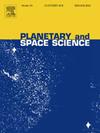论天体落在金星表面的方向性
IF 1.7
4区 物理与天体物理
Q3 ASTRONOMY & ASTROPHYSICS
引用次数: 0
摘要
这项研究表明,在解释金星上流星撞击位置时,对圆形数据分析的迫切需要。传统的线性方法需要改进,以捕捉这些数据的循环特性。我们可以使用专门的循环数据技术更好地识别模式和趋势,增强我们对流星撞击背后机制的理解。通过采用专门的统计技术捕捉角度数据的周期性,我们的分析包括0.05显著性水平的沃森检验,表明金星表面陨石坑数据集的位置参数和太阳高度符合冯米塞斯分布,而白天和夜间太阳高度则不符合。利用贝叶斯信息准则(BIC)得分,我们还确定了Fisher-von Mises分布的双组分混合最能模拟陨石坑的空间分布。这些发现增强了我们对金星流星撞击过程的理解,并突出了将最大熵方向模型应用于行星科学的优势。本文章由计算机程序翻译,如有差异,请以英文原文为准。
On the directional nature of the fall of celestial objects on the surface of Venus
This study demonstrates the critical need for circular data analysis in interpreting meteor impact locations on Venus. Traditional linear methods need to be improved to capture the cyclic nature of these data. We can better identify patterns and trends using specialized circular data techniques, enhancing our understanding of the mechanisms behind meteor impacts. By employing specialized statistical techniques that capture the cyclic nature of angular data, our analysis included Watson’s test at a 0.05 significance level, showing that the Venus surface crater dataset’s location parameters and solar elevations conform to a Von Mises distribution, while daytime and nighttime solar elevations do not. Using Bayesian Information Criterion (BIC) scores, we also determine that a two-component mixture of Fisher–von Mises distributions best models the spatial distribution of impact craters. These findings enhance our understanding of meteor impact processes on Venus and highlight the advantages of applying maximum-entropy directional models to planetary science.
求助全文
通过发布文献求助,成功后即可免费获取论文全文。
去求助
来源期刊

Planetary and Space Science
地学天文-天文与天体物理
CiteScore
5.40
自引率
4.20%
发文量
126
审稿时长
15 weeks
期刊介绍:
Planetary and Space Science publishes original articles as well as short communications (letters). Ground-based and space-borne instrumentation and laboratory simulation of solar system processes are included. The following fields of planetary and solar system research are covered:
• Celestial mechanics, including dynamical evolution of the solar system, gravitational captures and resonances, relativistic effects, tracking and dynamics
• Cosmochemistry and origin, including all aspects of the formation and initial physical and chemical evolution of the solar system
• Terrestrial planets and satellites, including the physics of the interiors, geology and morphology of the surfaces, tectonics, mineralogy and dating
• Outer planets and satellites, including formation and evolution, remote sensing at all wavelengths and in situ measurements
• Planetary atmospheres, including formation and evolution, circulation and meteorology, boundary layers, remote sensing and laboratory simulation
• Planetary magnetospheres and ionospheres, including origin of magnetic fields, magnetospheric plasma and radiation belts, and their interaction with the sun, the solar wind and satellites
• Small bodies, dust and rings, including asteroids, comets and zodiacal light and their interaction with the solar radiation and the solar wind
• Exobiology, including origin of life, detection of planetary ecosystems and pre-biological phenomena in the solar system and laboratory simulations
• Extrasolar systems, including the detection and/or the detectability of exoplanets and planetary systems, their formation and evolution, the physical and chemical properties of the exoplanets
• History of planetary and space research
 求助内容:
求助内容: 应助结果提醒方式:
应助结果提醒方式:


